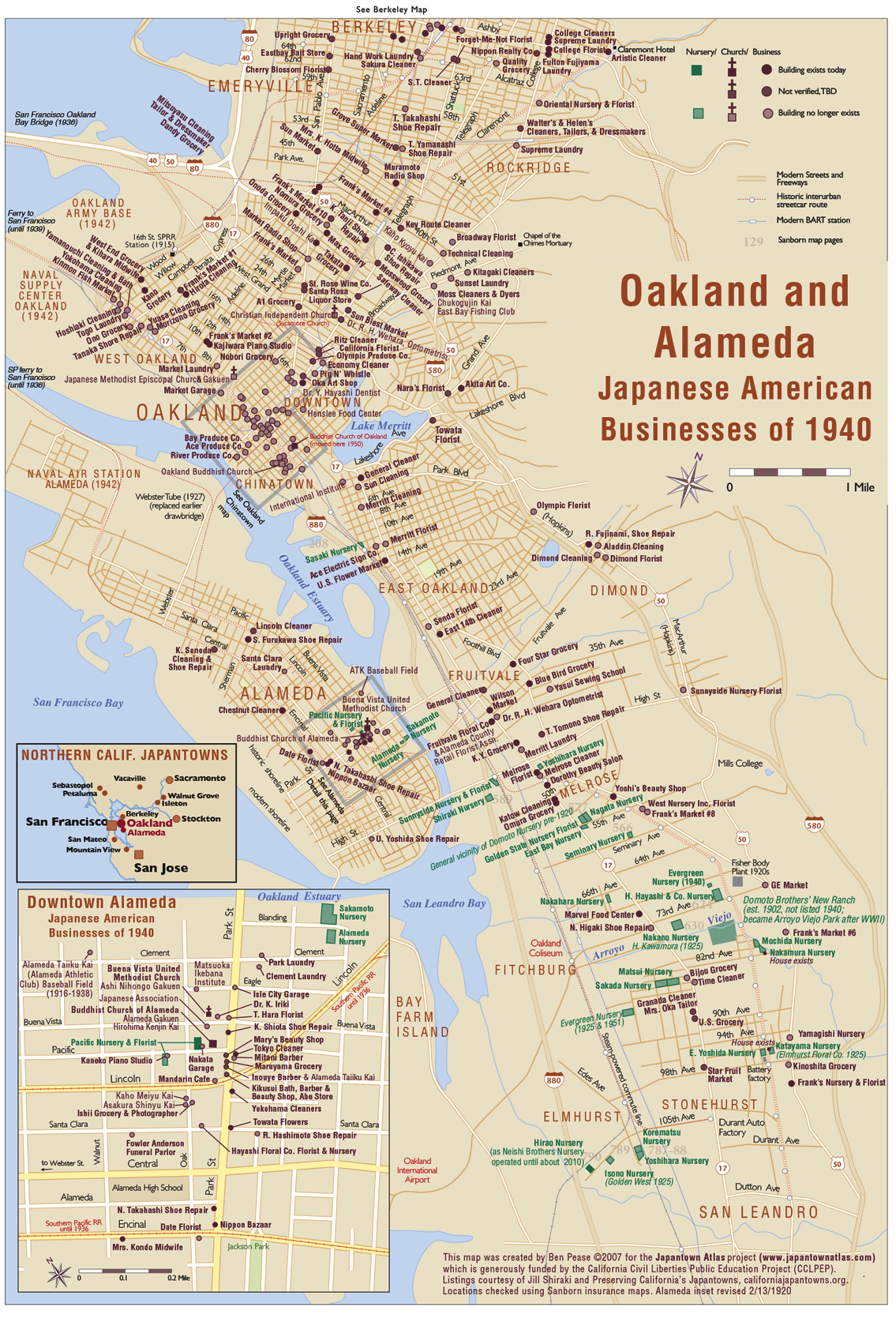![]() Japantown
Atlas - Northern California - Oakland and Alameda
Japantown
Atlas - Northern California - Oakland and Alameda
Overview Map: Oakland and Alameda Japanese American
Businesses of 1940 with an inset of Alameda's Park Street.

Oakland had a large and complex Japanese American community, which grew considerably after the 1906 earthquake and fire in San Francisco.Nikkei and non-Nikkei refugees took up residence in the East Bay and many set down roots. The main Japantown was in Chinatown, centered on 8th and Webster Streets, in Chinatown. Outside of downtown Oakland had numerous mom-and-pop sized businesses up and down the major streets and streetcar lines – Telegraph Ave, East 14th Street, and San Pablo Ave. The Preserving California's Japantown project reports that a relatively large percentage of Oakland/East Bay landmarks survive, mostly ordinary streetcar-era storefronts. There were Buddhist churches in both Oakland and Alameda, both of which worship today in their original buildings. Oakland's church was purpose-designed by architect George Shintoku Shimamoto (architect of the San Jose and San Francisco churches); Alameda's church occupies a donated Victorian mansion. There were also several Christian churches (Buena Vista United Methodist Church continues in its original location with the old church used as a social hall).
Alameda seems to have had a rather large Japanese American merchant presence on Park Street, serving its working- and owning-class populations, and (I speculate) perhaps also serving the large, local Japanese American population in adjacent East Oakland.
East Bay Flower Nurseries:
On the Oakland map I've shown nurseries in green, with the actual properties
outlined. Seeing all these nurseries mapped out, they are quite impressive.Oakland
was the center of the Japanese American flower nursery industry in the East
Bay, which extended from Richmond and El Cerrito to San Leandro and Hayward
(and also on the San Francisco Peninsula). The 1940 directories list nurseries
in many Bay Area cities, but Oakland's nurseries are the easiest to
map, as they all had street addresses in 1940 (whereas those in rural areas
still had rural delivery route or PO box addresses). So it was possible to find
the corresponding Sanborn pages and look for extant structures (or what replaced
them) on satelllite photos. Note that many of the nurseries are on creek bottoms,
where there was good groundwater; most are near historic railroad and streetcar
lines, which provided direct access to Oakland and San Francisco (via connecting
ferry).
One significant nursery that was NOT listed in 1940 was Domoto Brothers, a huge operation which trained so many future East Bay growers it was sometimes called "Domoto College." Starting in West Oakland near the turn of the century, the Domoto brothers relocated to East Oakland around 1910, and their operation grew to 40+ acres with 3 dozen greenhouses. On the 1924 Sanborn map it covers an entire page! Sometime in the late 1930s or early '50s this land became Oakland's Arroyo Viejo Park. The rustic stone bridge over the burbling arroyo may be the old nursery entrance; near the park's southeast corner a row of cypress trees were originally a windbreak around one of the Domoto residences or dormitories.
 Very
few Oakland nurseries survive today. The postwar housing boom, rising land prices,
and other factors have led to most being developed. Frank's Nursery
(Gomez Nursery) at 9875 MacArthur Blvd in East Oakland is closed but
extant in 2007. Neishi Bros. Nursery (formerly Hirao Nursery)
still operates a 3.8-acre farm on East 105th Ave. in 2006; they were kind enough
to let me visit their operation, now run by the 4th generation of the family.
The Korematsu and Yoshihara nursery sites
on Edes Ave. have been gone for a while, but the cleared lots are being developed
with a Habitat for Humanity housing project. The dwellings for the Katayama
and Nakamura nurseries are also extant, even though the adjacent
nursery land has been developed.
Very
few Oakland nurseries survive today. The postwar housing boom, rising land prices,
and other factors have led to most being developed. Frank's Nursery
(Gomez Nursery) at 9875 MacArthur Blvd in East Oakland is closed but
extant in 2007. Neishi Bros. Nursery (formerly Hirao Nursery)
still operates a 3.8-acre farm on East 105th Ave. in 2006; they were kind enough
to let me visit their operation, now run by the 4th generation of the family.
The Korematsu and Yoshihara nursery sites
on Edes Ave. have been gone for a while, but the cleared lots are being developed
with a Habitat for Humanity housing project. The dwellings for the Katayama
and Nakamura nurseries are also extant, even though the adjacent
nursery land has been developed.
7/22/07; rev 2/10/08 with input from historian Dean Yabuki
Notes: Japanese American busineses in Downtown Oakland and Chinatown are so dense they are shown here only with dots - see that map for names. The top of this map overlaps with our Berkeley map. Download a PDF of Oakland/Alameda/Berkeley (3 pages, 620 kb).
Preserving California's Japantowns plans an Oakland page with various historic
sites including Market Laundry.